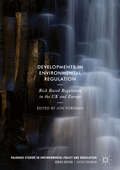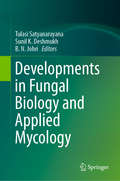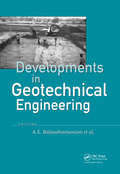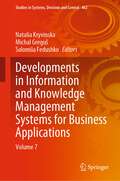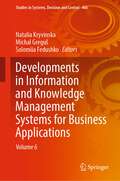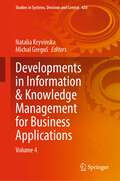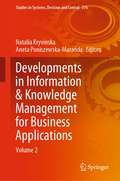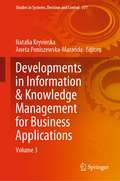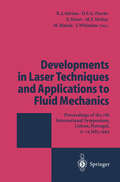- Table View
- List View
Developments in Environmental Regulation: Risk based regulation in the UK and Europe
by Jon ForemanThis book provides a critical examination of contemporary approaches to environmental regulation in the UK and the European Union. It also explores how regulation has evolved in response to a number of factors, including industrial development and improved scientific knowledge, while considering the radical next steps that need to be taken in response to existing challenges.Developments in Environmental Regulation draws its focus on the effects of risk-based approaches to the environmental regulation of business and industry, including its impact on sustainable economic growth. The book also considers the challenges and potential opportunities that surround the UK’s withdrawl, or ‘Brexit’, from the European Union. This edited collection has been written by a group of highly experienced regulatory specialists whose insightful perspectives on key areas of environmental regulation are situated at the core of this work. This book will appeal to students and academics, policy-makers and environmental practitioners interested in understanding how environmental policy and regulation is applied and how it can be adapted to its political context.
Developments in Environmental Regulation: Risk based regulation in the UK and Europe
by Jon ForemanThis book provides a critical examination of contemporary approaches to environmental regulation in the UK and the European Union. It also explores how regulation has evolved in response to a number of factors, including industrial development and improved scientific knowledge, while considering the radical next steps that need to be taken in response to existing challenges.Developments in Environmental Regulation draws its focus on the effects of risk-based approaches to the environmental regulation of business and industry, including its impact on sustainable economic growth. The book also considers the challenges and potential opportunities that surround the UK’s withdrawl, or ‘Brexit’, from the European Union. This edited collection has been written by a group of highly experienced regulatory specialists whose insightful perspectives on key areas of environmental regulation are situated at the core of this work. This book will appeal to students and academics, policy-makers and environmental practitioners interested in understanding how environmental policy and regulation is applied and how it can be adapted to its political context.
Developments in Fungal Biology and Applied Mycology
by Tulasi Satyanarayana Sunil K. Deshmukh B. N. JohriThis book explores the developments in important aspects of fungi related to the environment, industrial mycology, microbiology, biotechnology, and agriculture. It discusses at length both basic and applied aspects of fungi and provides up-to-date laboratory-based data. Of the estimated three million species of fungi on Earth, according to Hawksworth and coworkers, more than 100,000 have been described to date. Many fungi produce toxins, organic acids, antibiotics and other secondary metabolites, and are sources of useful biocatalysts such as cellulases, xylanases, proteases and pectinases, to mention a few. They can also cause diseases in animals as well as plants and many are able to break down complex organic molecules such as lignin and pollutants like xenobiotics, petroleum and polycyclic aromatic compounds. Current research on mushrooms focuses on their hypoglycemic, anti-cancer, anti-pathogenic and immunity-enhancing activities. This ready-reference resource on various aspects of fungi is intended for graduate and post-graduate students as well as researchers in life sciences, microbiology, botany, environmental sciences and biotechnology.
Developments in Geotechnical Engineering: from Harvard to New Delhi 1936-1994
by A.S.BALASUBRAMANIAM; S.W.HONG; D.T.BERGADO; N.PHIEN-WEJ; P.NUTALAYAThis book reviews the developments that have taken place in the field of geotechnical engineering since the first international conference on Soil Mechanics and Foundation Engineering was held in Harvard University in 1936 until the January 1994 conference in New Delhi, India.
Developments in Geotechnical Engineering: from Harvard to New Delhi 1936-1994
by A. S. Balasubramaniam D. T. Bergado S. W. Hong P. Nutalaya N. Phien-WejThis book reviews the developments that have taken place in the field of geotechnical engineering since the first international conference on Soil Mechanics and Foundation Engineering was held in Harvard University in 1936 until the January 1994 conference in New Delhi, India.
Developments in Information and Knowledge Management Systems for Business Applications: Volume 7 (Studies in Systems, Decision and Control #462)
by Natalia Kryvinska Michal Greguš Solomiia FedushkoThis book presents a combination of chapters assembled in different fields of expertise. The book examines different aspects of business knowledge from a philosophical and practical standpoint. This data helps modern organizations by providing valuable insights and suggestions for future research and results. The increasing number of business disciplines studied necessitates implementing effective analytics practices within organizations. This book explores disciplinary and multidisciplinary concepts and practical techniques to help analyze the evolving field.
Developments in Information and Knowledge Management Systems for Business Applications: Volume 6 (Studies in Systems, Decision and Control #466)
by Natalia Kryvinska Michal Greguš Solomiia FedushkoBy highlighting ongoing progress in structural management, this book of our subseries encourages further research regarding the subject. Companies need sustainable solutions to the pressure to deal with high levels of risk and uncertainty. Many companies face this challenge and, therefore, must find new ways to deal with it. These solutions are often based on digital-influenced techniques. Previously understood knowledge, technologies, and data provide a huge assist with this goal.
Developments in Information & Knowledge Management for Business Applications: Volume 1 (Studies in Systems, Decision and Control #330)
by Natalia Kryvinska Michal GregušThis book provides solutions to manage information competently in order to increase its business usage. The information/knowledge business is a highly-dynamic evolving industry, and the novel methodologies and practices for the business information processing, as well as application of mathematical models to the business analytics and efficient management, are the most essential for the decision-making and further development of this field. Consequently, in this series subline first volume, the authors study challenges and opportunities, as well as embrace different aspects of business information processing for an efficient enterprise management. The authors cover also methods and techniques, as well as strategies for the efficient business information processing for management. Besides, the authors analyse strategies for lowering business information/data loss, while improving customer satisfaction and maintenance levels. The major goal is to analyse the key aspects of managerial implications on the informational business on the continuous basis.
Developments in Information & Knowledge Management for Business Applications: Volume 5 (Studies in Systems, Decision and Control #421)
by Natalia Kryvinska Michal GregušThe book delivers an elaboration of multidisciplinary concepts, examples, and practices that can be useful for researching the evolution of developments in the field. In this book, we continue to provide a critical look at the information management in business organizations by exploring knowledge aspects from theoretical and practical perspectives. The compilation of chapters presented in this book helps to define the range of activities, identify areas for future research, and draw practical conclusions. The variety of industrial sectors examined supports continuous gaining and usage of an efficient business analysis in organizations.
Developments in Information & Knowledge Management for Business Applications: Volume 4 (Studies in Systems, Decision and Control #420)
by Natalia Kryvinska Michal GregušThis book discusses incentives for information management, usage of information for existing practices to become more efficient, the acceleration of executive learning, and an evaluation of the information management impact on an organization. In today’s COVID-influenced volatile world, companies face a variety of challenges. And the most crucial of them are high levels of uncertainty and risk. Therefore, companies are constantly under pressure to provide sustainable solutions. Accordingly, previously gathered knowledge and information can be extremely helpful for this purpose. Hence, this fourth book of our subseries continues to accentuate on different approaches, which point to the importance of continuous progress in structural management for sustainable growth. It highlights the permanent gain and usage of information. We would be pleased if the book can stimulate further research on this subject matter.
Developments in Information & Knowledge Management for Business Applications: Volume 2 (Studies in Systems, Decision and Control #376)
by Natalia Kryvinska Aneta Poniszewska-MarańdaThis book provides practical knowledge on different aspects of information and knowledge management in businesses. For enterprises/businesses those intend to remain prosperous and prolific, it is critically important to share best practices, ensure efficient information flow across company, capturing shared knowledge centrally, and communicate compliance rules, i.e. managing competently information in general. It enables faster and better decisions by helping employees’ to build a strong expertise and by avoiding duplicated projects. Thus, the second volume of this series subline continues to explore different aspects of information and knowledge handling as well as doing business with information. We survey further the key aspects of managerial implications of the informational business. The novel methodologies and practices for the business information processing as well as application of mathematical models to the business analytics and efficient management are examined.
Developments in Information & Knowledge Management for Business Applications: Volume 3 (Studies in Systems, Decision and Control #377)
by Natalia Kryvinska Aneta Poniszewska-MarańdaThis book provides practical knowledge on different aspects of information and knowledge management in businesses. In contemporary unstable time, enterprises/businesses deal with various challenges—such as large-scale competitions, high levels of uncertainty and risk, rush technological advancements, while increasing customer requirements. Thus, businesses work continually on improving efficiency of their operations and resources towards enabling sustainable solutions based on the knowledge and information accumulated previously. Consequently, this third volume of our subline persists to highlight different approaches of handling enterprise knowledge/information management directing to the importance of unceasing progress of structural management for the steady growth. We look forward that the works of this volume can encourage and initiate further research on this topic.
Developments in Injection Moulding—1
by A. Whelan J. L. CraftInjection moulding is the most important moulding process used by the plastics industry and some idea of its importance can be obtained by considering the following figures. The value of the UK market for plastics processing equipment was £60 million in 1977. Of this sum, £23 million was spent on injection moulding machines, that is, 40 % of all the money spent on plastics processing equipment in the UK. It has been estimated that one-third of all plastics materials are processed by injection moulding. At the present time the process is of greater importance to the thermoplastics industry but its relevance to the thermoset industry should not be ignored. Most ofthe equipment now used is based on single-screw pre-plasticising units. Once these machines had become established, in the 1960s, it was felt that the ultimate had been reached in machine design and utilisation. However, since that time, machines, processes and materials have undergone extensive development to make injection moulding safer, more reliable, easier to use and more economical to operate. The purpose ofthis book is to review some of the developments that have taken place in this very important area. These developments are described by specialists in the field, who have extensive industrial experience and whose contribution will therefore be of immediate relevance to those concerned with the usage and application of this, the most important plastics moulding process.
Developments in International Bridge Engineering: Selected Papers from Istanbul Bridge Conference 2014 (Springer Tracts on Transportation and Traffic #9)
by Alp Caner Polat Gülkan Khaled MahmoudThe book includes peer-reviewed contributions selected from presentations given at the Istanbul Bridge Conference 2014, held from August 11 – 13 in Istanbul, Turkey. It reports on the current challenges in bridge engineering faced by professionals around the globe, giving a special emphasis to recently developed techniques, innovations and opportunities. The book covers key topics in the field, including modeling and analysis methods; construction and erection techniques; design for extreme events and condition assessment and structural health monitoring. There is a balanced presentation of theory, research and practice. This book, which provides the readers with a comprehensive and timely reference guide on current practices in bridge engineering, is intended for professionals, academic researchers and students alike.
Developments in International Bridge Engineering: Selected Papers from Istanbul Bridge Conference 2018 (Springer Tracts on Transportation and Traffic #17)
by Polat Gülkan Alp Caner Nurdan Memisoglu ApaydinThis book reports on current challenges in bridge engineering faced by professionals around the globe, giving a special emphasis to recently developed techniques and methods for bridge design, construction and monitoring. Based on extended and revised papers selected from outstanding presentation at the Istanbul Bridge Conference 2018, held from November 5 – 6, 2018, in Istanbul, Turkey, and by highlighting major bridge studies, spanning from numerical and modeling studies to the applications of new construction techniques and monitoring systems, this book is intended to promote high standards in modern bridge engineering. It offers a timely reference to both academics and professionals in this field.
Developments in Ionic Polymers—2
by A. D. Wilson ProsserIonic polymers, like elephants, are easier to recognise than to define. Several methods of classification have been attempted but none is wholly satisfactory because of the extreme diversity of ionic polymers, which range from the organic, water-soluble polyelectrolytes, through hydrogels and ionomer carboxylate rubbers, to the almost infusible inorganic silicate minerals. For this reason, a general classification is not only difficult, but has minimal utility. However, there are some characteristics of these materials that should be highlighted. The role of counterions is the significant one. These ions, either singly or as clusters, take part in the formation of ionic bonds which have a varying structural role. Often they act as crosslinks, but in the halato-polymers the ionic bonds form an integral part of the polymer backbone itself. Conversely, in polymers contain ing covalent crosslinks, such as the ion-exchange resins, the coun terions have virtually no structural role to play, since they dwell in cage-like structures without affecting the crosslinking, and are readily exchanged. They are, perhaps, best described as ion-containing polymers rather than structural ionic polymers. Another crucial factor is the role of water in ionic polymers. The presence of ionic bonds means that there is a tendency for these materials to interact with water. Where the ionic polymer contains a high proportion of ionic units, it acts as a hydrogel and may be highly soluble. Such interactions with water decrease sharply as the ionic content is reduced, though even then water can act as a plasticiser.
Developments in Laser Techniques and Applications to Fluid Mechanics: Proceedings of the 7th International Symposium Lisbon, Portugal, 11–14 July, 1994
by M. V. Heitor M. Maeda J. Whitelaw R. J. Adrian D. F. G. Durao Franz DurstThis volume comprises a selection of the best papers presented at the Seventh Interna tional Symposium on Applications of Laser Techniques to Fluid Mechanics held at The Calouste Gulbenkian Foundation in Lisbon, during the period of July 11 to 14,1994. The papers describe Applications to Fluid Mechanics, Applications to Combustion, Instrumentation for Velocity and Size Measurements and Instrumentation for Whole Field Velocity and demonstrate the continuing and healthy interest in the development of understanding of the methodology and implementation in terms of new instru mentation. The prime objective of this Seventh Symposium was to provide a forum for the presen tation of the most advanced research on laser techniques for flow measurements, and communicate significant results to fluid mechanics. The applications oflaser techniques to scientific and engineering fluid flow research was emphasized, but contributions to the theory and practice of laser methods were also considered where they facilitate new improved fluid mechanic research. Attention was placed on laser-Doppler anemometry, particle sizing and other methods for the measurement of velocity and scalar, such as particle image velocimetry and laser induced fluorescence. We would like to take this opportunity to thank those who participated. The assistance provided by the Advisory Committee, by assessing abstracts was highly appreciated.
Developments in Laser Techniques and Fluid Mechanics: Selected Papers from the 8th International Symposium, Lisbon, Portugal 8–11 July, 1996
by R. J. Adrian D.F.G. Durao F. Durst M. V. Heitor M. Maeda J. H. WhitelawThis volume comprises a selection of the best papers presented at the Eighth International Symposium on Applications of Laser Techniques to Fluid Mechanics, held in Lisbon in July 1996.The papers describe novel ideas for instrumentation, instrumentation developments, results of measurements of wall-bounded flows, free flows and flames and flow and combustion in engines. The papers demonstrate the continuing interest in the development of an understanding of new methodologies and implementation in terms of new instrumentation.
Developments in Lubricant Technology
by S. P. SrivastavaProvides a fundamental understanding of lubricants and lubricant technology including emerging lubricants such as synthetic and environmentally friendly lubricants • Teaches the reader to understand the role of technology involved in the manufacture of lubricants • Details both major industrial oils and automotive oils for various engines • Covers emerging lubricant technology such as synthetic and environmentally friendly lubricants • Discusses lubricant blending technology, storage, re-refining and condition monitoring of lubricant in equipment
Developments in Lubricant Technology
by S. P. SrivastavaProvides a fundamental understanding of lubricants and lubricant technology including emerging lubricants such as synthetic and environmentally friendly lubricants • Teaches the reader to understand the role of technology involved in the manufacture of lubricants • Details both major industrial oils and automotive oils for various engines • Covers emerging lubricant technology such as synthetic and environmentally friendly lubricants • Discusses lubricant blending technology, storage, re-refining and condition monitoring of lubricant in equipment
Developments in Medical Image Processing and Computational Vision (Lecture Notes in Computational Vision and Biomechanics #19)
by João Manuel R. S. Tavares Renato Natal JorgeThis book presents novel and advanced topics in Medical Image Processing and Computational Vision in order to solidify knowledge in the related fields and define their key stakeholders. It contains extended versions of selected papers presented in VipIMAGE 2013 – IV International ECCOMAS Thematic Conference on Computational Vision and Medical Image, which took place in Funchal, Madeira, Portugal, 14-16 October 2013. The twenty-two chapters were written by invited experts of international recognition and address important issues in medical image processing and computational vision, including: 3D vision, 3D visualization, colour quantisation, continuum mechanics, data fusion, data mining, face recognition, GPU parallelisation, image acquisition and reconstruction, image and video analysis, image clustering, image registration, image restoring, image segmentation, machine learning, modelling and simulation, object detection, object recognition, object tracking, optical flow, pattern recognition, pose estimation, and texture analysis. Different applications are addressed and described throughout the book, comprising: biomechanical studies, bio-structure modelling and simulation, bone characterization, cell tracking, computer-aided diagnosis, dental imaging, face recognition, hand gestures detection and recognition, human motion analysis, human-computer interaction, image and video understanding, image processing, image segmentation, object and scene reconstruction, object recognition and tracking, remote robot control, and surgery planning. This volume is of use to researchers, students, practitioners and manufacturers from several multidisciplinary fields, such as artificial intelligence, bioengineering, biology, biomechanics, computational mechanics, computational vision, computer graphics, computer science, computer vision, human motion, imagiology, machine learning, machine vision, mathematics, medical image, medicine, pattern recognition, and physics.
Developments in Model-Based Optimization and Control: Distributed Control and Industrial Applications (Lecture Notes in Control and Information Sciences #464)
by Sorin Olaru Alexandra Grancharova Fernando Lobo PereiraThis book deals with optimization methods as tools for decision making and control in the presence of model uncertainty. It is oriented to the use of these tools in engineering, specifically in automatic control design with all its components: analysis of dynamical systems, identification problems, and feedback control design.Developments in Model-Based Optimization and Control takes advantage of optimization-based formulations for such classical feedback design objectives as stability, performance and feasibility, afforded by the established body of results and methodologies constituting optimal control theory. It makes particular use of the popular formulation known as predictive control or receding-horizon optimization.The individual contributions in this volume are wide-ranging in subject matter but coordinated within a five-part structure covering material on:· complexity and structure in model predictive control (MPC);· collaborative MPC;· distributed MPC;· optimization-based analysis and design; and· applications to bioprocesses, multivehicle systems or energy management.The various contributions cover a subject spectrum including inverse optimality and more modern decentralized and cooperative formulations of receding-horizon optimal control. Readers will find fourteen chapters dedicated to optimization-based tools for robustness analysis, and decision-making in relation to feedback mechanisms—fault detection, for example—and three chapters putting forward applications where the model-based optimization brings a novel perspective.Developments in Model-Based Optimization and Control is a selection of contributions expanded and updated from the Optimisation-based Control and Estimation workshops held in November 2013 and November 2014. It forms a useful resource for academic researchers and graduate students interested in the state of the art in predictive control. Control engineers working in model-based optimization and control, particularly in its bioprocess applications will also find this collection instructive.
Developments in Multidimensional Spatial Data Models (Lecture Notes in Geoinformation and Cartography)
by Alias Abdul Rahman, Pawel Boguslawski, Christopher Gold and Mohamad Nor SaidThis book presents the latest research developments in geoinformation science, which includes all the sub-disciplines of the subject, such as: geomatic engineering, GIS, remote sensing, digital photogrammetry, digital cartography, etc.
Developments in Oils and Fats
by R. J. HamiltonThis first volume in a series is intended to provide up-to-date information on specific topics in oils and fats. The book will be especially valuable for any practising scientist or technologist who deals in any way with oils and fats whether from a nutritional, surfactant, cosmetic or analytical chemistry point of view. In addition there is sufficient depth in most of the articles to catch the imagination of many more senior managers in the industry. The oils and fats industry is closely aligned with the food industry and it is no surprise to find that five of the chapters (1, 2, 3, 6 and 7) are written from a food perspective. The current arguments about diets and their fat content are well developed in Dr Enser's chapter on meat lipids. He has presented a very balanced picture explaining that there are many reports which contradict the fashionable 'saturated fatty acids are bad' theory. This chapter will do much to illustrate the dietary implications of meat lipids and should stimulate discussion and further research.
Developments in Oriented Polymers—2
by Ian M. WardThe last four years since the publication of the first of this series have seen further striking developments in both the science and technology of oriented polymers. In particular, polymers possessing very high degrees of molecular orientation are now quite commonplace, and this is reflected by the inclusion of five chapters dealing with ultra-high modulus polyethylene fibres, oriented liquid crystalline polymers (both lyotropics and thermo tropics) and polydiacetylene single crystal fibres. At the same time there is continuing interest in the structure and properties of less highly oriented polymers and in the mechanisms of deformation in polymers. It is therefore good to have these themes represented also. I should like to thank the contributors for adhering to a rather tight time schedule, and the publishers for their cooperation, so that this book can provide up-to-date reviews of the state of the art in a rapidly moving area of polymer science. I. M. WARD v CONTENTS Preface.... . . . .. . . . . .. ... . . . . . . . . . .. . . .. . . . . . . ... ... v List of Contributors. . . . . . . . . . . . . . . . . . . . . . . . . . . . . . . . . . . . IX 1. Polymer Single Crystal Fibres ........................ .
